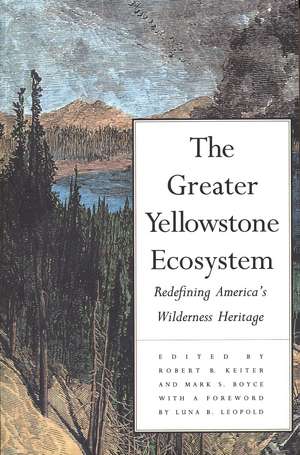The Greater Yellowstone Ecosystem: Redefining America`s Wilderness Heritage
Autor Robert B. Keiter Editat de Mark S. Boyceen Limba Engleză Paperback – 23 oct 1994
In 1872 Congress designated Yellowstone National Park as the world’s first national park; nineteen years later, the land adjacent to Yellowstone became America’s first national forest reserve. Since that time, the entire Yellowstone region has been the scene of major battles over resource management—debates between those who would use the land for extraction of national resources (mining, lumbering, and hunting, for example) and those who believe that wildlife and recreation should dominate land use.
In this book, experts in science, economics, and law discuss key resource management issues in the greater Yellowstone ecosystem, using them as a starting point to debate the manner in which humans should interact with the environment of this area. Some authors reflect upon the summer 1988 fires at Yellowstone and review the role and effect of fire in the ecosystem. Others offer opinions on appropriate management of elk and bison, key attractions to Yellowstone since its inception. Still others address the question of whether wolves—now a missing component of the Yellowstone ecosystem—should be restored to the region. A final essay by editors Robert B. Keiter and Mark S. Boyce suggests how ecosystem management principles will affect Greater Yellowstone’s future and how an ecological process management philosophy might be implemented.
This important book, which includes special archival photographs of the Yellowstone area, will be the major source of information on this land for years to come. It is also valuable for all who are interested in how wildlands throughout the world can be preserved in their natural state in the face of accelerating human encroachment.
.In this book, experts in science, economics, and law discuss key resource management issues in the greater Yellowstone ecosystem, using them as a starting point to debate the manner in which humans should interact with the environment of this area. Some authors reflect upon the summer 1988 fires at Yellowstone and review the role and effect of fire in the ecosystem. Others offer opinions on appropriate management of elk and bison, key attractions to Yellowstone since its inception. Still others address the question of whether wolves—now a missing component of the Yellowstone ecosystem—should be restored to the region. A final essay by editors Robert B. Keiter and Mark S. Boyce suggests how ecosystem management principles will affect Greater Yellowstone’s future and how an ecological process management philosophy might be implemented.
This important book, which includes special archival photographs of the Yellowstone area, will be the major source of information on this land for years to come. It is also valuable for all who are interested in how wildlands throughout the world can be preserved in their natural state in the face of accelerating human encroachment.
Preț: 438.80 lei
Nou
Puncte Express: 658
Preț estimativ în valută:
83.97€ • 87.89$ • 69.88£
83.97€ • 87.89$ • 69.88£
Carte tipărită la comandă
Livrare economică 31 martie-14 aprilie
Preluare comenzi: 021 569.72.76
Specificații
ISBN-13: 9780300059274
ISBN-10: 0300059272
Pagini: 442
Dimensiuni: 152 x 229 x 32 mm
Greutate: 0.65 kg
Ediția:Revised
Editura: Yale University Press
Colecția Yale University Press
ISBN-10: 0300059272
Pagini: 442
Dimensiuni: 152 x 229 x 32 mm
Greutate: 0.65 kg
Ediția:Revised
Editura: Yale University Press
Colecția Yale University Press








